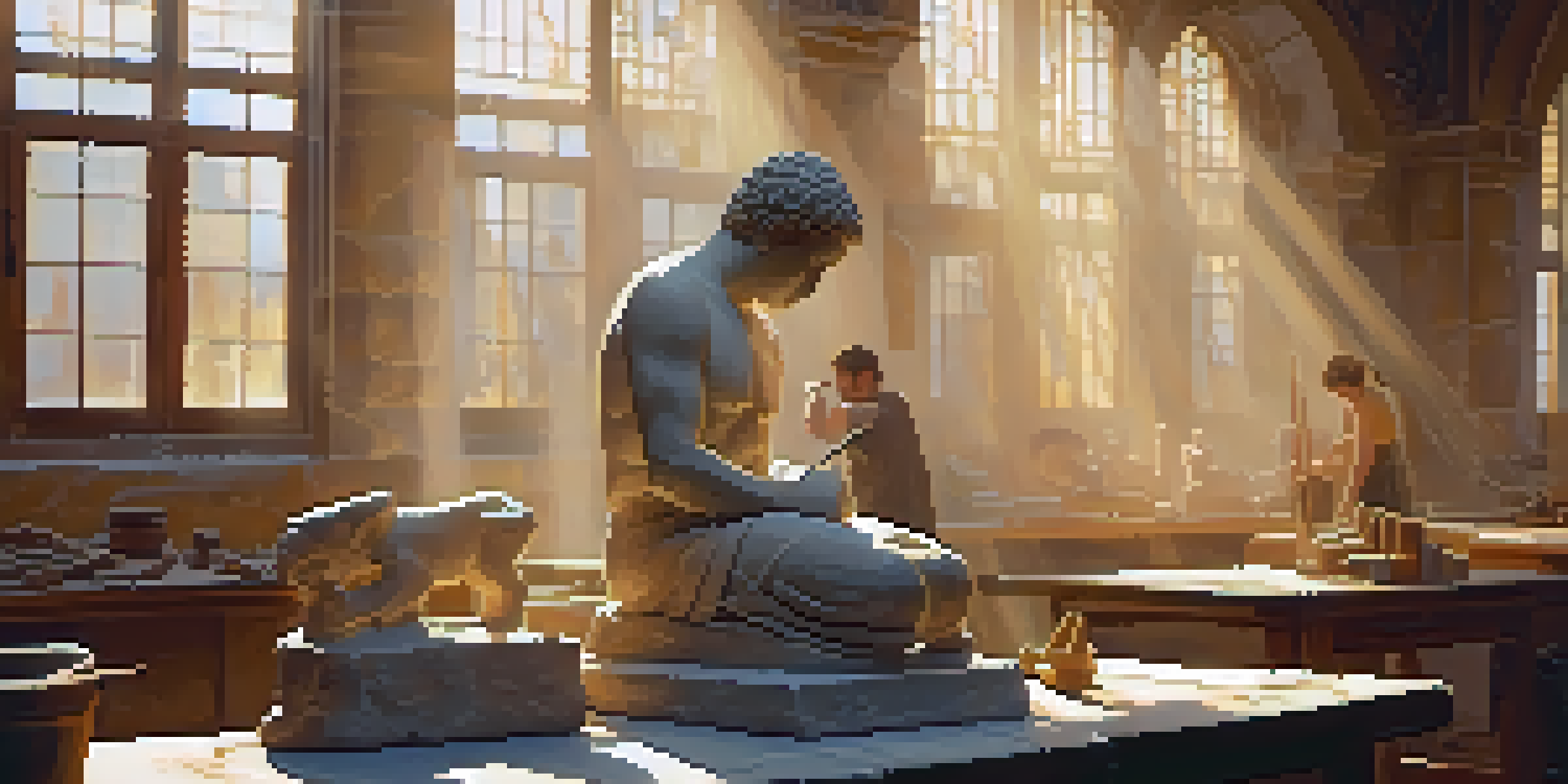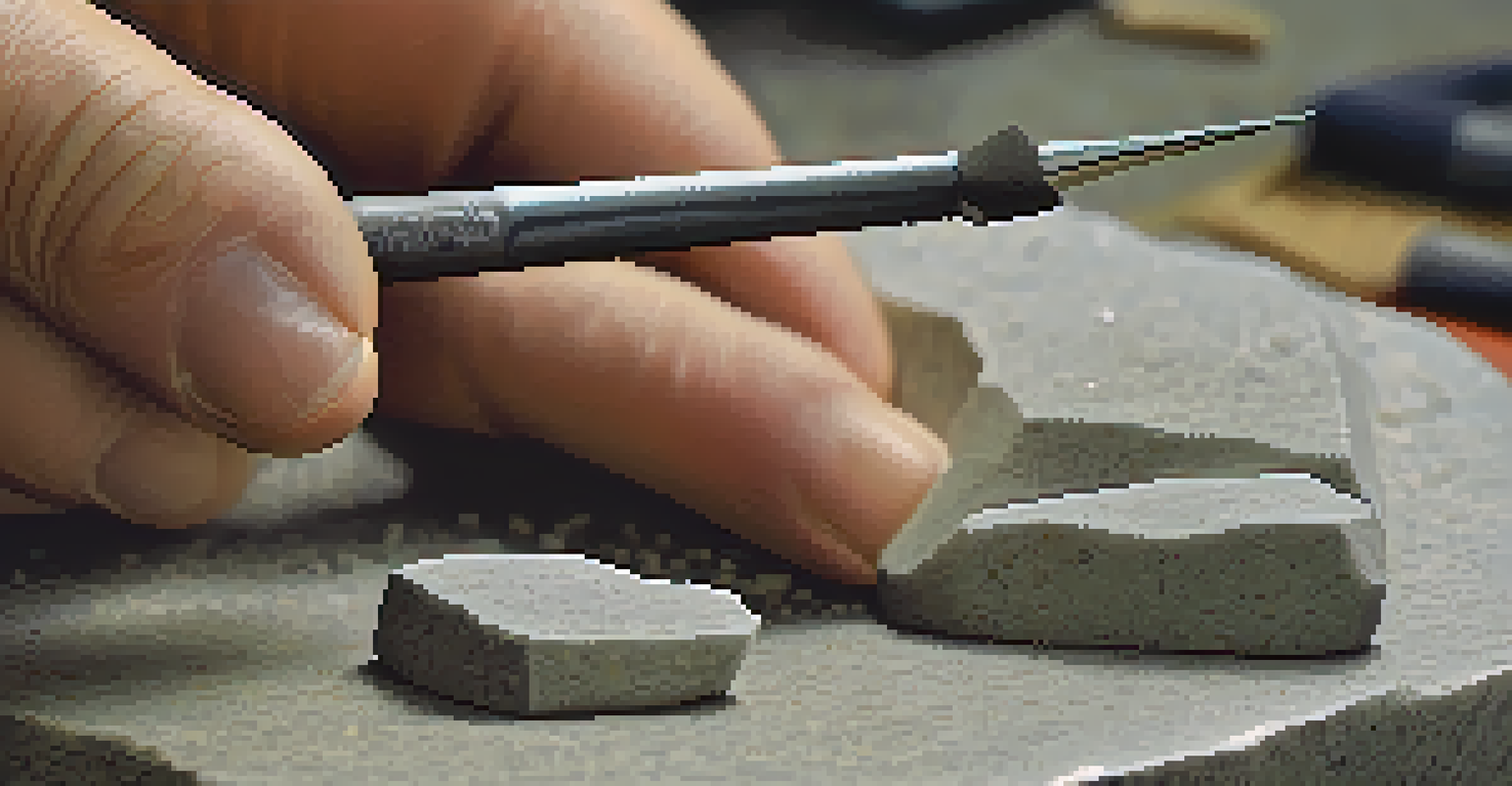Techniques of Stone Carving: Tools and Methods for Artistry

Understanding the Basics of Stone Carving Techniques
Stone carving is an ancient art form that transforms rough stones into beautiful sculptures. At its core, it requires a blend of creativity and technical skill, making it both a craft and an art. Understanding the basics of stone carving involves knowing the types of stones available and how they can be shaped. Each stone has its unique properties, which impact the carving process and the final outcome.
Every artist dips his brush in his own soul, and paints his own nature into his pictures.
For instance, softer stones like soapstone are easier to carve and great for beginners, while harder stones like granite require more advanced techniques. This variation influences not just the tools you'll use but also the artistic approach you might take. Ultimately, a solid grasp of the fundamentals can pave the way for more intricate designs and expressions.
In essence, mastering the basics of stone carving sets the foundation for artistic growth, allowing artists to explore their creativity while ensuring their techniques are sound.
Essential Tools for Stone Carving: An Overview
Every stone carver needs a specific set of tools to bring their vision to life. These tools can range from simple hand tools to advanced machinery, depending on the complexity of the project. Common hand tools include chisels, hammers, and rasps, which are essential for shaping and detailing the stone. Each tool serves a distinct purpose, allowing artists to achieve varying levels of precision and texture.

For example, a point chisel is used to remove large amounts of stone quickly, while a flat chisel is perfect for creating smooth surfaces. As carvers become more experienced, they may incorporate power tools like grinders and diamond saws, which can greatly speed up the process. However, it's important to balance the use of these modern tools with traditional techniques to maintain a personal touch in the artwork.
Basics of Stone Carving Techniques
Understanding the fundamentals of stone carving, including stone types and techniques, is essential for artistic growth.
Ultimately, having the right tools at your disposal not only enhances the efficiency of the carving process but also empowers artists to explore new techniques and styles.
Traditional Hand Tools: Chisels and Hammers
The heart of stone carving lies in the use of traditional hand tools, particularly chisels and hammers. These tools have been used for centuries and are still favored by many artists for their control and precision. A skilled carver can create intricate designs by manipulating these tools with finesse, making each strike count. The relationship between the hammer and chisel is symbiotic; the hammer provides the force, while the chisel directs that force.
Art is not freedom from discipline, but disciplined freedom.
Different types of chisels serve various purposes, such as the pointed chisel for rough shaping and the flat chisel for smoothing surfaces. Learning how to effectively use these tools takes practice, but the tactile feedback they provide can be immensely rewarding. Many artists find joy in the rhythm of striking the hammer and watching the stone yield to their will.
In essence, traditional hand tools not only form the backbone of stone carving but also connect the artist with the rich history of the craft.
Modern Tools: Power Tools for Precision and Speed
While traditional tools have their charm, modern power tools have revolutionized the stone carving industry. These tools can significantly reduce the time it takes to shape stone, allowing artists to focus more on the creative aspects of their work. For instance, angle grinders and pneumatic chisels can quickly remove material and create complex shapes that would be difficult to achieve with hand tools alone.
However, it's important to approach these tools with caution and respect, as they can be quite powerful and may lead to mistakes if used carelessly. Many artists choose to combine both hand and power tools in their workflow, utilizing the strengths of each to achieve the desired effect. This hybrid approach can lead to stunning results, blending the beauty of traditional craftsmanship with the efficiency of modern technology.
Importance of Choosing the Right Stone
Selecting the appropriate stone based on its characteristics directly influences the outcome and design of the sculpture.
Ultimately, embracing modern tools can enhance an artist's ability to innovate and push the boundaries of their stone carving practice.
Techniques for Shaping: From Roughing to Finishing
Shaping stone is a multi-step process that requires a clear understanding of various techniques. Initially, roughing out the shape involves removing large chunks of stone to create a basic form. This is typically done using larger chisels and hammers, allowing artists to establish the overall dimensions of their sculpture. As the piece begins to take shape, carvers transition to finer tools for detailing.
Finishing techniques are equally important, as they determine the final appearance of the sculpture. Techniques such as sanding and polishing can enhance the stone's natural beauty, revealing its color and texture. Additionally, certain finishes can create different visual effects, making the artwork truly unique. Taking the time to refine these techniques can elevate a piece from simply being a sculpture to a true work of art.
In summary, mastering the techniques of shaping and finishing is crucial for any stone carver looking to create stunning pieces that resonate with viewers.
Choosing the Right Stone: Characteristics and Considerations
Selecting the right stone is a critical step in the stone carving process, as each type of stone offers distinct characteristics. Factors such as hardness, grain, and color can greatly influence the outcome of a sculpture. For example, marble is prized for its beauty and workability, making it a favorite among sculptors, while basalt is much harder and requires more effort to carve.
Artists must also consider the intended use of the final piece; a sculpture for outdoor display may need more durable stone compared to one meant for indoor exhibition. Additionally, the stone's natural patterns and colors can inspire the design, leading artists to adapt their vision based on the material at hand. Understanding these characteristics not only aids in choosing the right stone but also enhances the creative process.
Safety Practices in Stone Carving
Prioritizing safety measures, such as wearing protective gear and maintaining a clean workspace, is crucial in stone carving.
In essence, the right stone can serve as both a canvas and a partner, guiding the artist's hand toward creating remarkable works of art.
Safety Practices in Stone Carving: Protecting Yourself
Safety should always be a top priority when engaging in stone carving. The use of sharp tools and heavy machinery can pose significant risks, so understanding safety practices is essential. Wearing protective gear, such as goggles, gloves, and dust masks, can help prevent injuries and minimize exposure to harmful dust. Additionally, maintaining a clean and organized workspace reduces the likelihood of accidents.
It's also important to be aware of your surroundings and the tools you're using. Taking the time to familiarize yourself with each tool’s operation can prevent mishaps and ensure a smoother carving experience. Furthermore, understanding the specific safety protocols for power tools is crucial, as these can be more dangerous than hand tools.

Ultimately, prioritizing safety in stone carving allows artists to focus on their creativity while ensuring they can continue to carve for years to come.